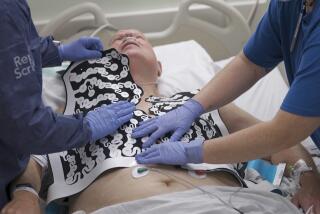Laser Procedure Promising in Treating Heart Ailments
- Share via
MOUNTAIN VIEW, Calif. — A laser capable of destroying diseased tissue without harming healthy cells may open new avenues of treatment for cardiovascular patients, doctors say.
In recent years, lasers have been supplanting some of the more conventional tools of medicine. Heart surgeons, however, have been wary of jumping on the bandwagon because of the difficulty and danger of aiming a lethal weapon at a continuously moving target.
‘Probe and Treat’
The new computerized “Probe and Treat” laser may change that, doctors said. Initial tests at the National Institutes of Health and in France showed the system operates with unprecedented accuracy and speed. Thus, it can wipe out problem areas without damaging any of the surrounding tissue, an achievement that has eluded other lasers.
That is good news for 63 million Americans who suffer from one or more forms of cardiovascular disease, doctors said.
Each year, 1 million of them die, 100,000 undergo limb amputation, 1.5 million suffer a heart attack and 500,000 have a stroke, according to the American Heart Assn.
Seven million people in the country are afflicted with coronary artery disease caused by blockages of the heart’s arteries, 4 million with hypertension due to blocked kidney arteries, and another 4 million with blocked leg arteries.
Once the laser gains federal approval for wider use--expected within 18 months barring any unforeseen obstacles--it could help some of the 50% of heart patients who are not candidates for such conventional treatments as bypass surgery and balloon angioplasty.
In angioplasty, surgeons insert through the arteries a tiny balloon mounted on the end of a tube. Doctors inflate the balloon to enlarge artery openings narrowed by build-ups of plaque, or fatty deposits of cholesterol, cellular waste products, calcium and fibrin, a clotting material found in the blood.
In addition, the new laser could serve as an adjunct to the 550,000 heart bypass surgeries and angioplasties performed each year, said Dr. Douglas Murphy-Chutorian, a cardiologist and president of MCM Laboratories Inc. of Mountain View, which produces the system. Eventually, he said, laser treatment may replace some current cardiovascular procedures.
“The most difficult area of medicine and surgery in which to use a laser is the vascular,” said Murphy-Chutorian, former co-director of the Cardiovascular Laser Laboratory at the Stanford University Medical Center, where the country’s first laser angioplasty to open blocked leg arteries was performed in 1983.
“The target is hard to see because of heart motion, breathing and blood flow. It is risky for the physician to both aim the laser and discern precisely the amount of laser energy to apply.”
To date, a significant percentage of laser cardiovascular surgeries have been complicated by perforations, dissection, pain and vessel spasm, he said.
In initial tests, the new laser system distinguished between plaque and normal tissue every time and never fired on healthy areas surrounding a diseased treatment site.
Results of the experiments were reported at a recent annual meeting of the American College of Cardiology in Atlanta.
93% Success Rate
Doctors from NIH in Bethesda, Md., and the Henri-Mondor Hospital in Paris had a 93% success rate in reopening blocked leg arteries. The laser was used to open a primary channel through the blockage. Standard balloon angioplasty was then performed.
Of 28 patients who had been considered untreatable, 26 underwent successful operations.
“No other laser system for the treatment of atherosclerotic blockages has produced such remarkable results in ‘impossible’ cases such as these,” said Dr. H. J. Geschwind, director of the Cardiac Catheterization Laboratory at the Paris hospital.
“More trials are needed to prove the laser’s safety and efficacy, but we are excited about the very successful preliminary results,” said Murphy-Chutorian.
The laser system actually consists of two lasers: a low-power diagnostic laser, which probes to find diseased tissue, and a high-energy treatment laser, which vaporizes the plaque into harmless gases absorbed by the blood.
The entire process, guided by a computer, takes a fraction of a second and repeats continuously throughout the treatment.
During laser angioplasty, one end of an optical fiber is attached to a laser outside the body, while the other end is passed through the patient’s arteries to the site of the blockage. When the laser is fired, energy travels along the optical fiber, out the other end, and the plaque is vaporized.
By contrast, balloon angioplasty merely remolds the plaque, leaving material behind, which leads to reclosure of the artery 30% of the time.
“We hope the laser will significantly decrease recurrence by removing blockages entirely rather than just pushing them aside and by not damaging the lining of the vessel wall,” Murphy-Chutorian said.
The NIH is awaiting Food and Drug Administration approval to use the laser on coronary arteries.
The FDA has given the green light to additional trials on 250 patients with blocked leg vessels at Massachusetts General Hospital, Montefiore Medical Center in New York, Meriter Hospital in Madison, Wis.; Graduate Hospital in Philadelphia, and University of California, San Francisco.




